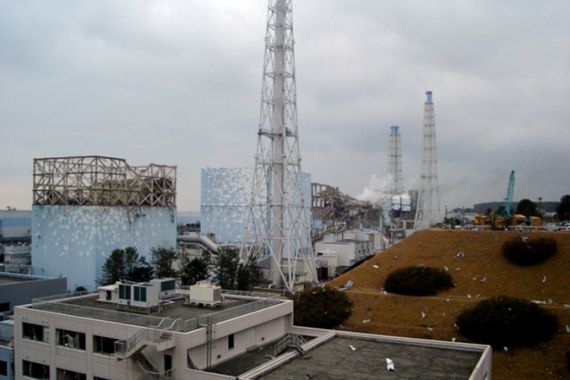Japan on ‘alert’ over radiation fears
Government acknowledges the situation is “grave” as it continues efforts to bring nuclear crisis under control.

 |
| The government is seeking advice on widening the evacuation zone around the Fukushima plant [AFP] |
Japan’s prime minister says the country remains on “maximum alert” as authorities struggle to bring a nuclear crisis under control more than two weeks after a devastating earthquake and tsunami.
Naoto Kan told parliament on Tuesday that the crisis remains unpredictable, reiterating that the country is facing its worst problems since World War II.
Keep reading
list of 4 itemsTurtles swimming to extinction in Malaysia as male hatchlings feel heat
Could shipping containers be the answer to Ghana’s housing crisis?
Thousands protest against over-tourism in Spain’s Canary Islands
“This quake, tsunami and the nuclear accident are the biggest crises for Japan” in decades, Kan said. “From now on, we will continue to handle it in a state of maximum alert.”
His comments came after nuclear officials announced that toxic plutonium has been seeping from a damaged nuclear power plant in Japan’s tsunami disaster zone into the soil outside.
Plant operator Tokyo Electric Power said the samples were taken a week ago.
‘Not a risk’
Safety officials said on Tuesday that the small amounts of plutonium found at several spots outside the complex were not a risk to humans.
But they said the finding supports suspicions that dangerously radioactive water is leaking from damaged nuclear fuel rods at the plant.
Al Jazeera’s Marga Ortigas reported from Yamagata that the government is trying to contain the toxic plutonium to the area around the nuclear plant within the compound.
“We understand that sand bags are being used, they are also considering erecting cement walls around areas where there might be leaks so that it doesn’t go outside of the plant complex itself.
The news came as Japanese officials raced to bring the crisis at the Fukushima Dai-ichi nuclear power plant under control.
“The situation is very grave; we are doing our utmost efforts to contain the damage,” Yukio Edano, chief cabinet secretary, said.
‘Crisis mishandled’
Tokyo Electric Power Company (TEPCO) has come under fire for its handling of the crisis, the world’s biggest atomic accident since Chernobyl in 1986, and looks likely to face a hefty compensation bill.
“It is naturally possible to hold various discussions on how TEPCO should function in future,” said Koichiro Gemba, minister of national policy, adding that nationalisation was “an option”, Kyodo News reported.
However, citing government sources, the Yomiuri Shimbun, Japan’s daily, said on Tuesday the government is assessing taking a majority stake in TEPCO as well as bearing responsibility for paying liabilities stemming from the nuclear plant crisis.
According to reports, the government has grown frustrated by missteps in the effort to stabilise the overheated facility.
“At the moment TEPCO are saying that their main task is still to keep the reactors cool to prevent overheating,” our correspondent added.
“So while they are pouring in more water, it could exacerbate the leaks. That’s the problem at the moment and they need to find a balance between those two situations.”
Extending evacuation zone
Some opposition lawmakers lambasted prime minister Kan in parliament for not extending an evacuation zone around the plant.
Meanwhile, Kan said he was seeking advice on widening the area, which would force 130,000 people to move in addition to 70,000 already displaced.
According to a local survey released by the Japanese media on Monday, “most of the people in Japan are pleased with the way the government has handled the humanitarian side of this latest crisis.
“However, they are not pleased at all by the way it has handled the nuclear problems that Fukushima is encountering.”
The nuclear fears have compounded the humanitarian disaster following the March 11 earthquake and tsunami. The death toll from the disaster has risen to 11,000 people, with more than 17,000 still missing.
“Now there is concern for quarter of a million people who have been left homeless,” our correspondent said.
Meanwhile, Katherine Mueuller, communications delegate for International Red Cross, told Al Jazeera that Japan is still very much in crisis mode.
“It is still very much a disaster zone in those evacuation areas. We are finding that we have more than 240,000 people who are still living in about 1,900 evacuation centres.
“People are saying that they are getting three square meals a day, they have water, they have blankets. But heat is a major issue, it is still in short supply.
“The refineries have come back on line but that is not being seen at the pumps yet.
“So to either fuel the vehicles to take supplies to the evacuation centres or to be able to heat these evacuation centres is a real challenge.”